OUR SERVICES
| Bridges | |
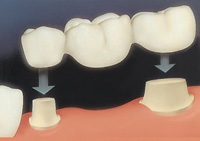 |
We will prescribe a bridge when one or more teeth are missing and there are healthy teeth on both sides of the open space. Bridges can be made from three types of material: solid gold for reliable long wear, porcelain fused to a gold base for strength and beauty, and high-strength metal-free porcelain for optimum cosmetic results |
| Crowns | |
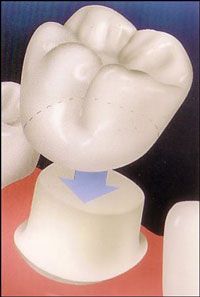 |
Crowns are prescribed when a tooth or teeth are too badly decayed, broken or cracked to be easily restored with a filling. Crowns are normally needed for teeth that have had root canals, but can also be placed on dental implants to replace missing teeth. Crowns can be made entirely of gold or porcelain fused to a gold substrate for strength and beauty. However, with new technology, crowns can be made entirely from high-strength ceramic and porcelain for beautiful cosmetic results. |
| Dentures | |
 |
If you have lost some or all of your natural teeth, dentures can be used to replace your missing teeth – improving your health as well as your appearance. Dentures prevent the sagging of facial muscles, which can make a person with missing teeth look much older. Dentures also enable you to eat and speak normally, little things often taken for granted until natural teeth are lost. |
| Fillings | |
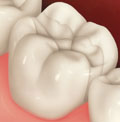 |
For hundreds of years, dental fillings have been used to restore teeth. Dental fillings are placed in teeth where a dentist has had to remove tooth structure due to decay or fracture. In recent years filling materials have been substantially improved by many technological advancements. Although silver amalgam was the dominant choice years ago, today we have several other preferred options for tooth restoration including tooth colored composite filling materials and cementable resins and porcelains. |
| Hygiene | |
The basis of sound dental care is routine cleaning and maintenance. We customize cleanings on the basis of your periodontal (gums and bone) health. We utilize medicated gels along with prescription mouth rinses in problem areas if necessary. Ultrasonic scalers are sometimes used to make the procedure more comfortable and effective as well. |
|
| Implants | |
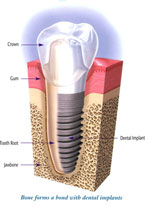 |
When it comes to replacing one or more teeth in your mouth, a dental implant is often the treatment of choice and is also one of the most conservative treatments for tooth replacement. Implants are biocompatible posts that replace the roots of your missing teeth. They are physically and biologically designed to attach to your jaw bone and become the foundation for a natural looking restoration. |
| Inlays & Onlays | |
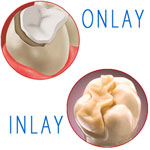 |
Dental inlays and onlays are some of the strongest and most lifelike dental restorations available. After your mouth has been anesthetized, we prepare the tooth in much the same way we would for a standard filling. When the tooth has been prepared to our satisfaction, an impression is made and sent to a dental lab. You will usually be required to wear a temporary filling until the restoration is fabricated. With proper care, your inlay or onlay will increase your overall health and instill confidence for years to come. |
| Invisalign | |
 |
Your Invisalign treatment will consist of a series of aligners that you switch out about every two weeks. Each aligner is individually manufactured with exact calculations to gradually shift your teeth into place. And since your Invisalign system is custom-made for your teeth and your teeth only, with a plan devised by you and your dentist or orthodontist, you know you'll end up with a smile that truly fits. |
| Orthodontics | |
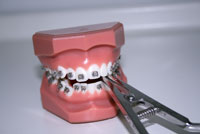 |
Orthodontics is a branch of dentistry specializing in the diagnosis, prevention, and treatment of jaw, face and bite irregularities (malocclusions*). Orthodontic treatment is provided by an oral health care provider known as an Orthodontist, who has typically completed two to three years of additional training beyond dental school. |
| *Malocclusion is the technical term for teeth that don’t fit together correctly. Malocclusions not only affect the teeth, but also the appearance of the face. Most malocclusions are inherited; however some are due to acquired habits such as thumb sucking and tongue thrusting. The spacing left from an adult tooth being extracted or an early loss of a baby tooth can also contribute to a malocclusion. | |
| Periodontitis | |
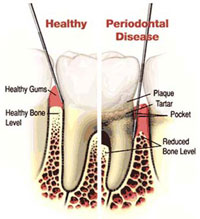 |
Gum disease is usually caused by plaque, a sticky film of bacteria that constantly forms on teeth. If plaque is not removed with thorough daily brushing and cleaning between teeth, gums become irritated and inflamed. The irritated gum tissue can separate from the teeth and form spaces called pockets. Bacteria move into the pockets where they continue to promote irritation. Left untreated, the process can continue until the bone and other tooth-supporting tissues are destroyed. The early stage of periodontal disease is called gingivitis. It often results in gums that are red and swollen and may bleed easily. |
| Root Canal | |
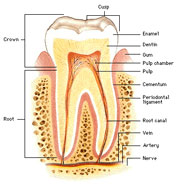 |
Endodontic treatment, more commonly known as root canal therapy, is necessary when the pulp of your tooth becomes inflamed or infected. The inflammation or infection can have a variety of causes such as deep decay, repeated dental procedures on your tooth, or a crack or chip in the tooth. With proper care, an endodontically treated tooth will function normally for years to come. |
| Veneers | |
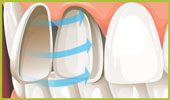 |
Unlike a crown, which covers the entire tooth, a veneer is a thin shell that is placed over the front or visible parts of the tooth. There are two types of veneers: ceramic veneers that are produced by a dental laboratory and resin-based composite veneers. With proper care, your new veneers will greatly improve your appearance and increase your confidence for years to come. |
| Whitening | |
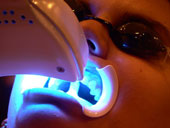 |
Everyone loves a bright, white smile. Today there are a variety of products and procedures available to help you improve the color of your teeth. Some whitening procedures, such as Zoom, are done in our office with one visit. Other whitening agents can be purchased over-the-counter, however this type of whitening does not whiten your teeth as quickly or as effectively as those delivered by your dentist. |
| Wisdom Teeth | |
 |
Wisdom teeth, or third molars, are the last teeth to erupt in your mouth and are the teeth least needed for good oral health. Most people have four wisdom teeth that usually erupt through the gums in their late teens or early twenties. Sometimes wisdom teeth remain trapped in the jawbone under the gums because there is insufficient room for them to erupt. |

